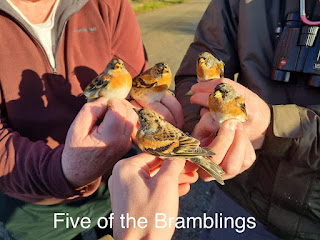A cold snap has hit the UK, but a mere detail like that is as nothing to the boys and girls of the mighty Stanford Ringing Group!
On Saturday 10th December, the temperature varied from a decidedly nippy -3 degrees C, to a comparatively balmy +1. Not put off, a large team met up at 0600. Dawn and Beth went to the Paddock, whilst Adam, Dave, Jade, Jo, Stuart and Peter met up on the rail track. Battling with frozen guys and sub zero metal polls, we put up nets from Safari to Box 16, plus the Paddock giving a total of 27, a mammoth undertaking. Despite the cold, it was a sunny morning with very little wind, so it perhaps wasn't quite as challenging as this photo might suggest:
The first round was very productive, with a good number of thrushes, both resident and winter visitors:
It is particularly nice to have decent numbers of Fieldfare; the total for 2022 is 24 so far, in comparison to a decidedly meagre single bird in the previous year.
The totals from both locations were, for new birds: Wren 2, Dunnock 1, Blackbird 11, Fieldfare 2, Song Thrush 3, Redwing 23, Blackcap 1 and Reed Bunting 3. We were really pleased to re-trap a number of our resident species, who seem to be surviving the cold weather very well, these were: Wren 7, Dunnock 4, Robin 9, Blackbird 3, Cetti's Warbler 2, Long Tailed Tit 2, Blue Tit 7 and Great Tit 3. Also, we had a re-trap Yellowhammer, which is a very rare event- the first since 2001!
Well 2022 is drawing to a close, and in many ways it has been a horrible year, but nothing puts off our birds as they go through their lives, perhaps a lesson for all of us. Last words go to one of our residents:
'Merry Christmas, see you in 2023!'



























